52 Weeks of Historical How-To’s, Week 21: Calligraphy
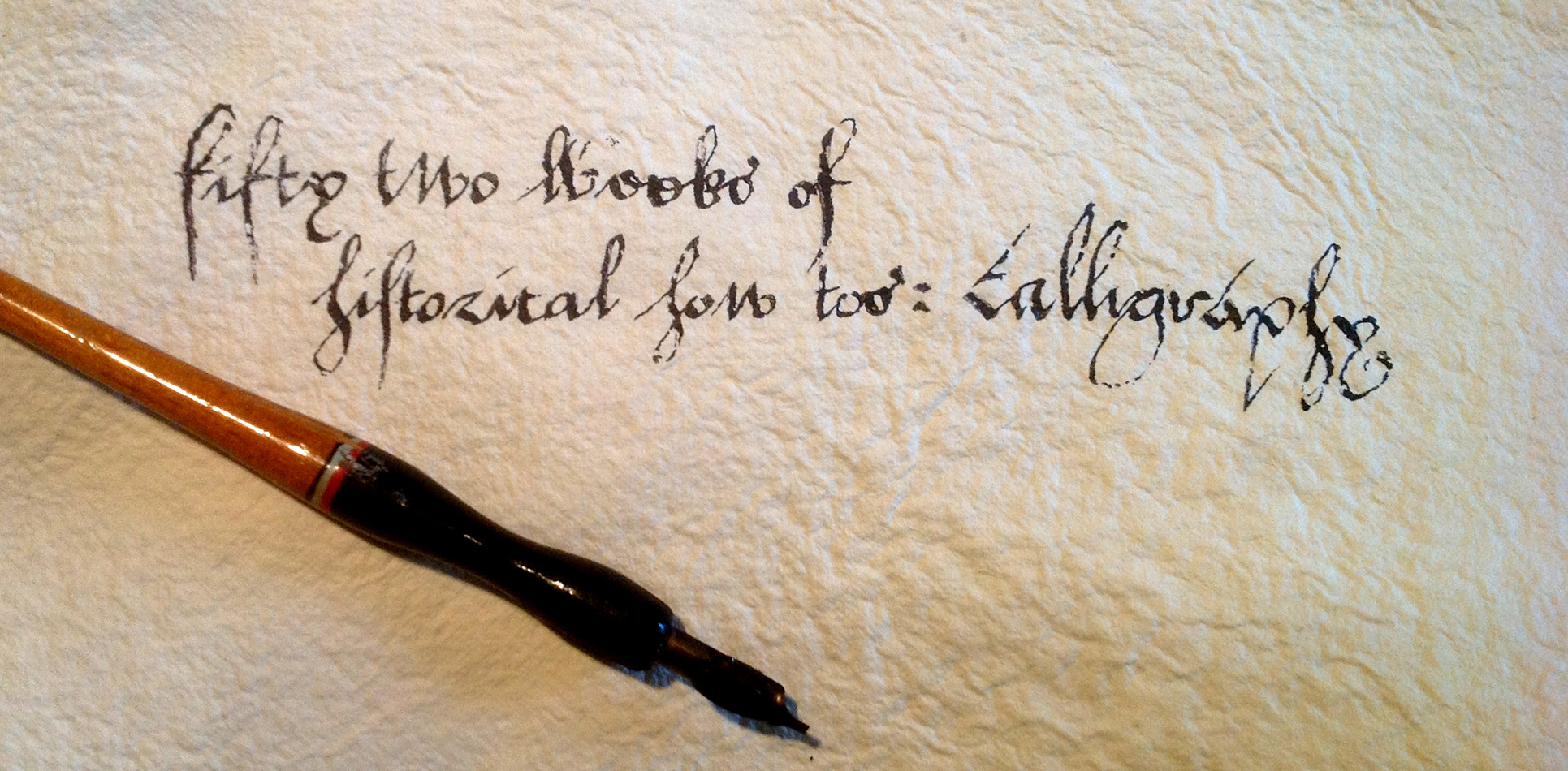
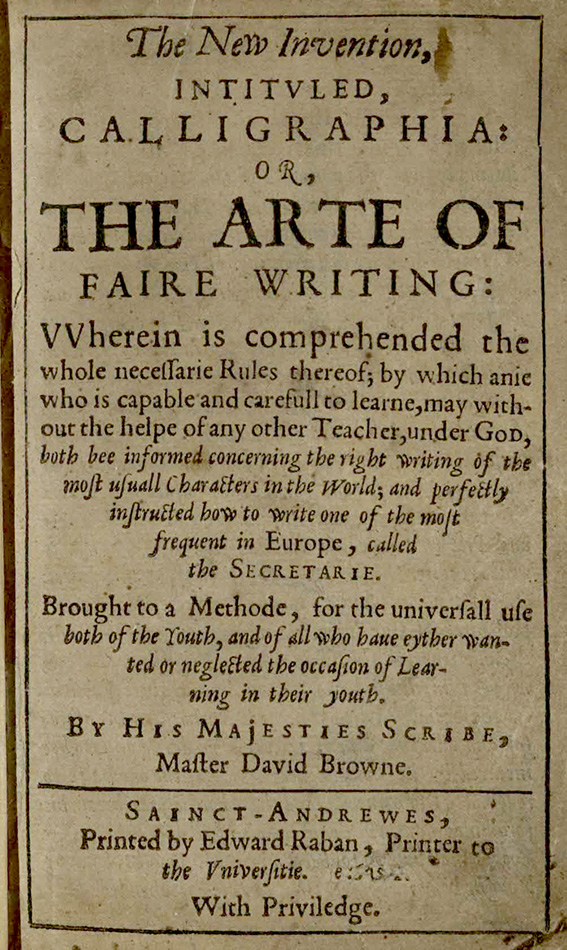
For this week’s historical how-to, we’re taking a look at David Browne’s The new invention, intituled, calligraphia: or, The arte of faire writing. Printed right here in St Andrews in 1622, it instructs the reader in the “right writing of the most usuall characters in the world,” in particular, the script known as secretary hand.
Secretary hand was a style of handwriting which developed in England in the 16th century and remained in use into the 17th century. Most commonly used for business purposes, it is a cursive script, meaning that the pen does not leave the page between letters, allowing it to be written at speed.
Scots secretary hand is generally accepted to be different from its English counterpart and owes its origins as much to French influence as to English. Scots Secretary is more difficult to read, being generally more “crabbit.” (For more detailed information about secretary hand, see Scottishhandwriting.com’s 1-hour tutorial, English Handwriting1500-1700: an online course, and Palaeography: reading old handwriting 1500-1800.)
Although Browne’s treatise appears more than 150 years after the invention of printing, there was still a thriving class of professional writing masters. In Scottish handwriting, 1150-1650, Grant G. Simpson writes that, “Specialised teachers of writing had existed on the continent since the fifteenth century and in England from about the second quarter of the sixteenth century… Some of these foreign writing masters advanced their profession by publishing copy-books of alphabets and specimen texts from which pupils could work.”

Calligraphia is one such work, although looking at the first several sections of the text, you might never guess that it was intended as a practical manual. It is with good reason that Simpson describes Browne’s style as “pretentious, his matter is full of prosy moralising and his practical advice is very slight.” It is only after 56 pages of dedications, introductions, and outlines of the text that Browne begins to describe the preparation of the pen and paper, and the best methods of holding and arranging them; and it is only after a further 121 pages that he begins to describe the method of forming the letters. Instead, he soliloquizes at considerable length on the importance of his subject on moral and theological grounds.
God Himself, Browne argues, wrote on the Mosaic tablets of the law, and, more importantly, Christ is referred to as the Eternal Word of God. Writing, therefore, is a divine task imparted to beings made in the image and likeness of God. Because our ability to write is divine, writing evinces a more intimate connection between the contents of the mind and the parchment. Language is an expression of the mind in written form and should be treated with reverence and care.
More practically, writing documents by hand showed higher regard for the subject matter than the comparatively cheap mass-production of printed texts. Legal documents such as treaties, legal notices, property deeds, and other instruments of business were still being written by hand to underscore the seriousness and dignity of the transaction.
Nevertheless, in Browne’s opinion, printing had its place too. Printing has the power to broadcast messages to a wide audience in a greater volume and at far less expense than handwritten items. Thus, to advertise his own business as writing master, Browne turned to the medium of the printed word.
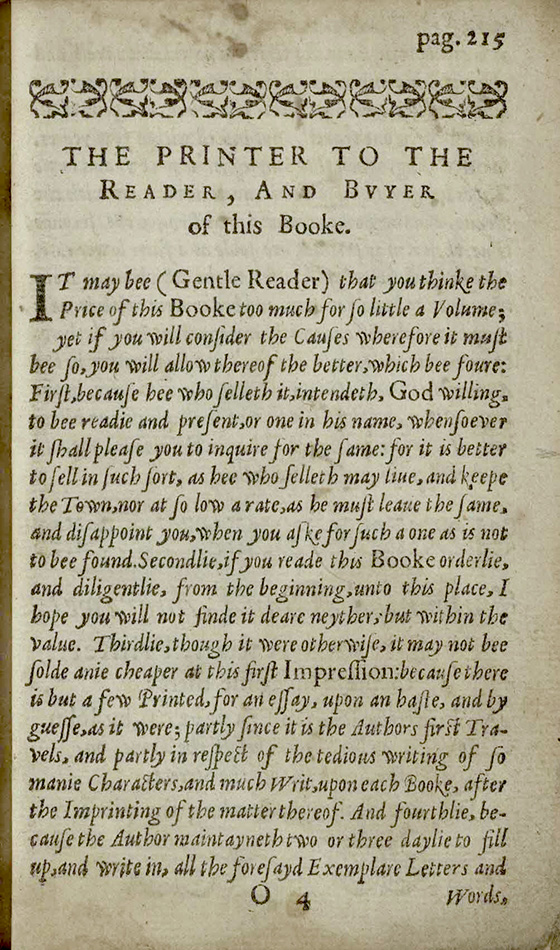
Unfortunately for Browne, the publication does not appear to have been a successful one. On the last two pages of the book is a notice from “the printer to the reader, and buyer of this booke,” which sheds some light on the circumstances of its publication. The notice begins, “It may bee (Gentle Reader) that you thinke the Price of this Booke too much for so little a Volume,” and proceeds to outline various reasons why it should be so. The first reason given is to keep the publisher and bookseller in business, “as hee who selleth may live, and keep the Town, nor at so low a rate, as he must leave the same, and disappoint you, when you aske for such a one as is not to bee found.” (Apparently, the high cost of living in St Andrews is nothing new.)
This notice appears to have been a prophetic one. Later that same year, the printer, Edward Raban, left St Andrews for Aberdeen where he remained for the remaining 36 years of his life and where, presumably, there was more business to support him. Likewise, by the time Browne’s second work was published in 1638, he had relocated from St Andrews to London.
Another reason given for the volume’s high price tag was “because there is but a few Printed… partly in respect of the tedious writing of so manie Characters.” Rather than commission a new set of type or a series of woodcuts to print examples of the secretary, italic, or other scripts, Raban left blank spaces in the text which Browne would then fill in by hand, a process which took many hours. Although we do not know exactly how many copies were printed, only 13 copies (including the one held by the University of St Andrews) have been reported to the English Short Title Catalogue. Of those 13 copies, we have been able to identify just six that have been filled in, three of those being only partially completed. (Six copies have been identified as blank, and one institution has yet to reply to our enquiry.) [Updated 24 March 2014].
St Andrews’ copy is, unfortunately, among the ones that have not been filled in, and so for our how-to, we had a go at filling in the blanks ourselves–not in the original, of course, but in scanned copies. Pages 121-136 describe, stroke by stroke, how to form each of the lower-case/minuscule letters of the secretary alphabet. Aided by a photograph of the handwritten alphabet in the University of Glasgow’s copy (classmark: Sp Coll Mu31-h.3), we attempted to work backwards from Browne’s instructions to identify which letters were described on each page, and then to write the letters ourselves following the directions in the text.
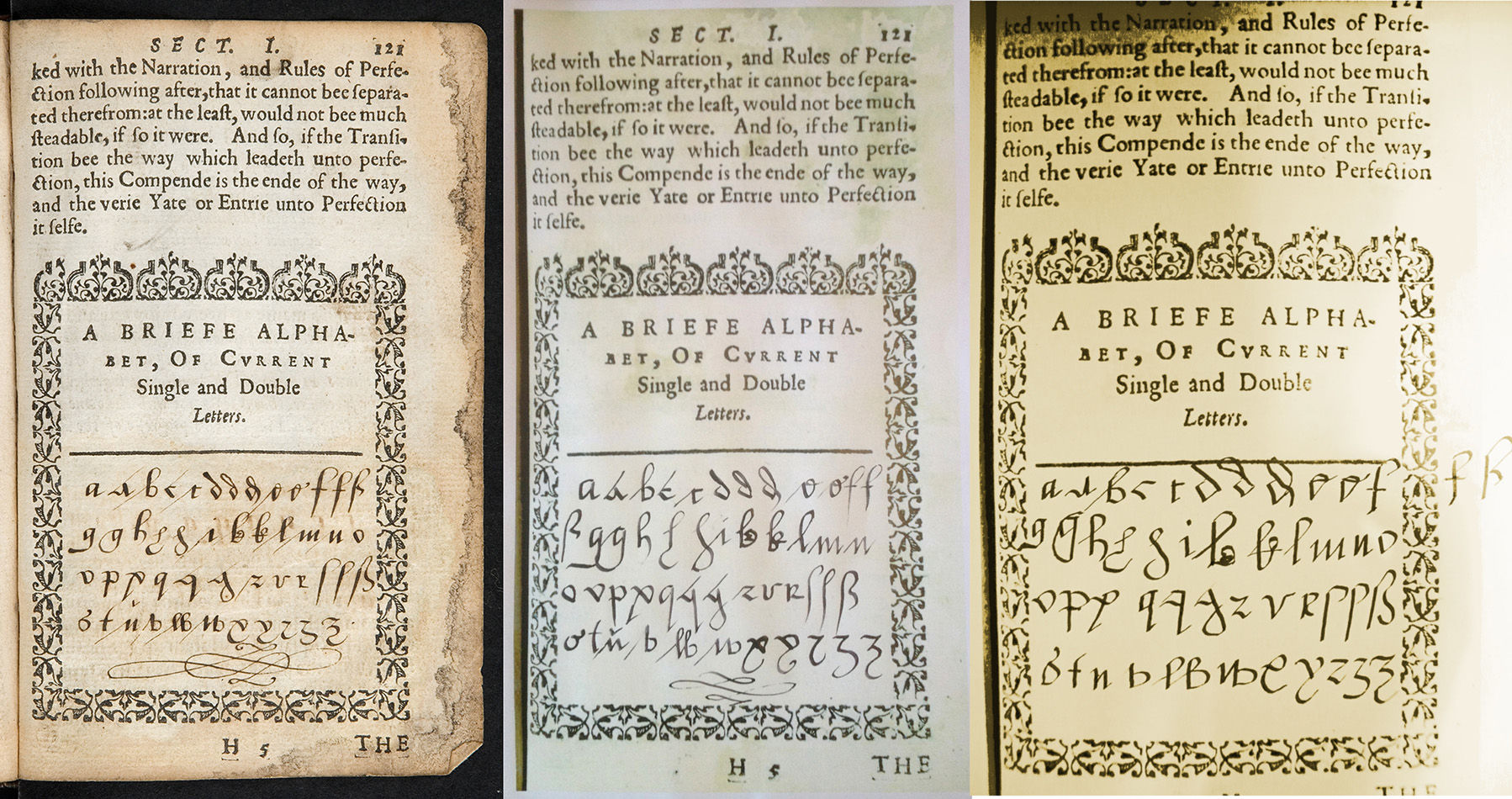
This task was complicated by the fact that the letters are not described in alphabetical order, but grouped into sets of letters with similar shapes (for example, a, q, and g). For a few of the letters, it took another email to Robert MacLean, Assistant Librarian, Special Collections at the University of Glasgow to identify which letters were described (Thank you, Bob!), but here is a sample of our results:
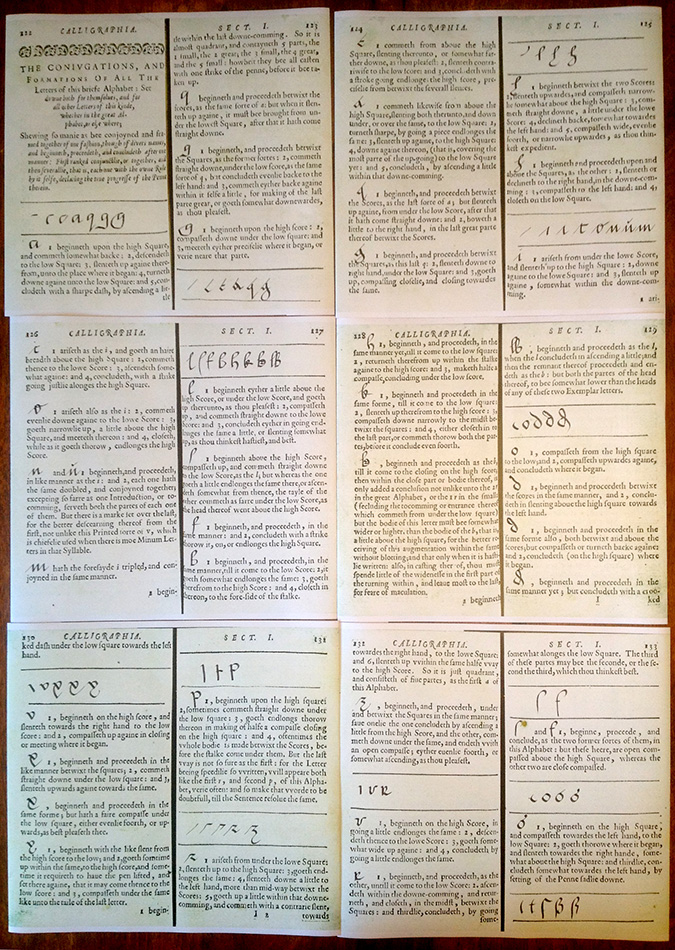
The two of us who attempted to re-create Browne’s lettering have had the advantage of calligraphy lessons in the past, but secretary hand was a new script to both of us, and we found it surprisingly challenging. Some of the letter shapes (such as l and t) are almost identical to the cursive script that we learned in school, but others (like the r, k, e, and s) are completely different. In addition, where modern calligraphers are taught to lift the pen after each stroke so that the direction of the strokes are always down and to the right, never up and to the left, secretary hand was designed for speed, and Browne’s instructions encourage the reader to make each letter in as few strokes as possible, regardless of direction.
For a couple of novices, the process of learning this new script was slow and painstaking—just the opposite of what the secretary hand is supposed to be—but writing out words and sentences in this script provided some insight into aspects of secretary hand that may confuse modern readers. For example, several of the letters in secretary hand can be written in more than one way. (The alphabet on Glasgow’s copy features two different ways of writing a, two c’s, three d’s, 3 f’s, two g’s, three h’s, two k’s, two o’s, three q’s, and so on.) Of the three different ways of writing the letter r, one begins and ends with the pen at the bottom of the line; the second begins and ends with the pen at the top of the line; the third begins at the top and ends at the bottom. After a bit of practice, it became obvious that one form of the letter would connect better with the letters immediately before and after it.
Finally, although we did not go so far as to follow Browne’s instructions for cutting our own quills, we did make use of the iron gall ink and handmade paper that featured in the last two weeks’ posts. For the most part, the iron gall ink behaved much like what you might buy at the store today, though possibly a little bit thicker. (This could be adjusted by adding a little wine or spirit vinegar.) When first mixed, however, the iron gall ink starts out a dark blue-grey colour, darkening to black over the next few days. This darkening occurs whether on the page or in a jar, so the ink came out of the jar a different colour on Wednesday than it did on Friday, but by Monday morning, all of the lettering matched. Today, more than a week after it was made, the ink still writes beautifully and shows no signs of spoiling, although the scent of the wine used to mix the ink remains quite strong.
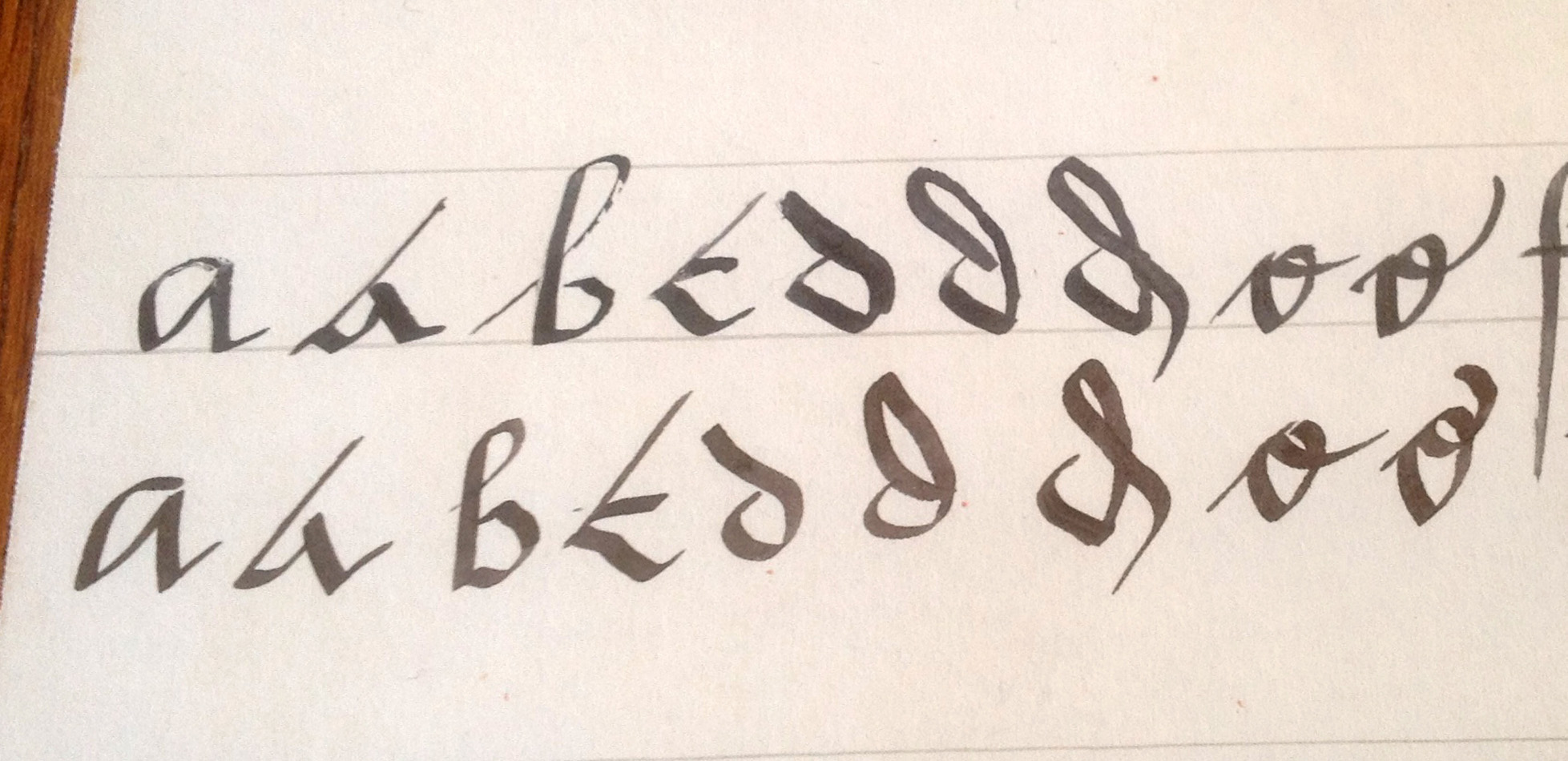
The handmade paper proved a bit more challenging to work with. If there was too much ink on the pen, it tended to saturate the paper, making it easy to tear with the sharp corners of the metal nib. Furthermore, the papers, which were pressed and dried between layers of kitchen towels, tended to take on the texture of the towel. While waffle weave makes for a visually intriguing paper, it makes a very challenging writing surface!
Despite a certain amount of frustration in learning this new script, we found this foray into 17th century penmanship to be a rewarding experience that was worth the time and energy. The act of treating language with such intense reverence and care that can be highly invigorating, and has the added benefit of leaving you with a beautiful finished product.
If you fancy trying your own hand at secretary hand, you can download our scans of Browne’s instructions for the lower-case secretary alphabet here: Alphabet pages PDF.
You can also watch a video of the banner image (top of post) being written out in this short clip:
– Christine Megowan and Marc Cole
Sources referred to:
Grant G. Simpson, Scottish handwriting, 1150-1650 : an introduction to the reading of documents. (Edinburgh: Bratton Publishing Ltd, 1973), 28-29.
George Herbert Bushnell, The Life and Work of Edward Raban St Andrews’ Most Famous Printer. (St Andrews & Cupar: J. & G. Innes, Ltd., 1928), 39.
Always fascinating - admirable that you practiced it too!
[…] of a David Hume work in my actual hands (I forget which…but it was old!), or writing a joint blog post on calligraphy, or writing a blog on the Crombie Collection. My time on LtP is filled with amazing moments like […]